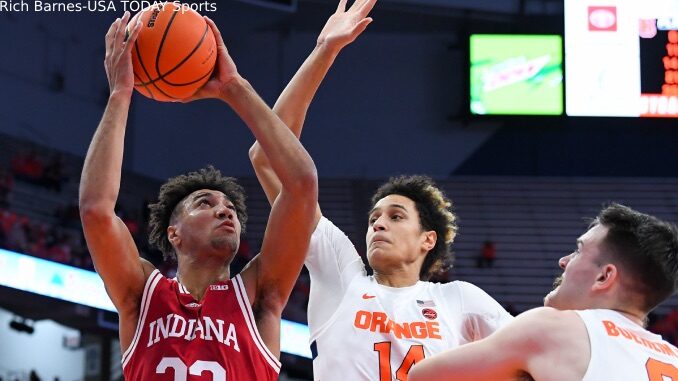
There is no secret as to why the Syracuse Orange missed the postseason following the 2021-2022 basketball season. The team finished outside the top 200 in adjusted defensive efficiency in Ken Pomeroy’s rankings, giving up over 75 points per game. The squad permitted opponents to score 80 points or more in a game nine times this season, as well as giving up 79 points thrice along with 78, 77, and 76 points once each.
A general lack of athleticism among the guards and wings was to blame, as SU’s 2-3 zone could not keep up with quick passes, getting beat inside and out with rotations too slow to keep up. That lack of athleticism tied directly into a couple things that traditionally help the Orange defense win games, creating blocks and steals, which are the changes of possession most easily converted to fast break points, and three-point percentage allowed.
In the eight previous seasons, Syracuse was 66-10 when piling up a combined 15 blocks and steals. This year’s defensively-challenged squad kept up its effectiveness when it managed to collect 15 blocks and steals, going 5-0 in those contests.
Of course, in the previous eight seasons, they had accomplished the feat an average of 9.5 times. Simply being able to amass more steals and blocks looks like a straight line to appearing more frequently on the happy side of the scoreboard.
But, that other stat about three-point shooting…
If you have read on this site the rantings of someone blathering on about Syracuse shooting at least 34 percent from three-point range while holding opponents to 30 percent or lower from distance, I am the ranter in question. Of course, when they reach these two benchmarks, the Orange are 58-6 (.906 win percentage) since joining the ACC. That’s reason enough to rant about it.
Part of the reason it was so disheartening this year to watch the defense struggle was knowing how easy it was for this year’s team to shoot at least 34 percent from three-point range. Led by Cole Swider and Joe Girard, who shot over 40 percent each from deep, Syracuse made 37.7 percent of their triples on the season, including besting that 34 percent baseline mark 21 times in their 33 games.
The easiest recent comparison is the Orange group from 2016-2017, who went to the NIT. They shot 38.1 percent from three, also surpassing the 34 percent mark 21 times, but in 34 games. However, Syracuse finished 18-3 in those contests. Their opponents shot 30 percent or lower from three-point range in 11 of those games with SU rolling up a 10-1 record in those outings.
This year’s Orange went 13-8 in those 21 games when they were proficient from outside. In nine of those games, the opponent shot under 30 percent from beyond the arc. Their record in those nine games was 7-2, leaving them 6-6 in the games where they shot well from outside, but did not defend the three-point line well.
So, even with a batch of proficient perimeter shooters, it was not enough for this year’s team. Syracuse did better as their three-point shooting reached more extreme heights this season, going 12-5 when they shot at least 38 percent from beyond the arc and 9-2 when they connected on over 42 percent.
That said, the Orange managed to lose a game to Miami in which they shot 53.1 percent from long range, making a season-high 17 three-pointers. Clearly, three-point shooting alone cannot win games, despite what the 2016-17 team stats might suggest.
And that’s why there should be some optimism for next season’s team, even with so much offensive firepower headed out the door and leaving what will be a mostly inexperienced roster behind.
» Related: Could Boeheim’s retirement coincide with reaching 1,000 win plateau?
Jesse Edwards was a revelation as the season progressed. While his smooth offense garnered the headlines when his play took off, Edwards blocked 2.8 shots per game, including five or more in a game three times. A return to health and another offseason of growth could make him an even better backbone of the defense.
While not ideal in size or athleticism for the top line of the zone, Girard led the team in steals, showing the anticipation needed to play passing lanes for deflections. Should Symir Torrence parlay his strong ACC Tournament play into a role in the starting lineup next to Girard, they should be at least an adequate duo on the top line of defense, although they will be undersized.
Benny Williams’ tantalizing athleticism and quick hands, when augmented with more work in the zone, make him look like a classic Syracuse wing who can potentially wreak havoc on opponents with double-teams, traps, and weak-side rim protection.
It is unknown at this time of Cole Swider is going to opt for one more run with the Orange and, if he does choose to return, his shooting will be welcomed. And his experience on defense should not be overlooked as part of his potential return. He is not a terrific athlete, but maybe he can get a little better.
Just like SU’s defense.
For more Syracuse coverage, Like our Facebook page, follow us @TheJuiceOnline and listen to our podcast.

